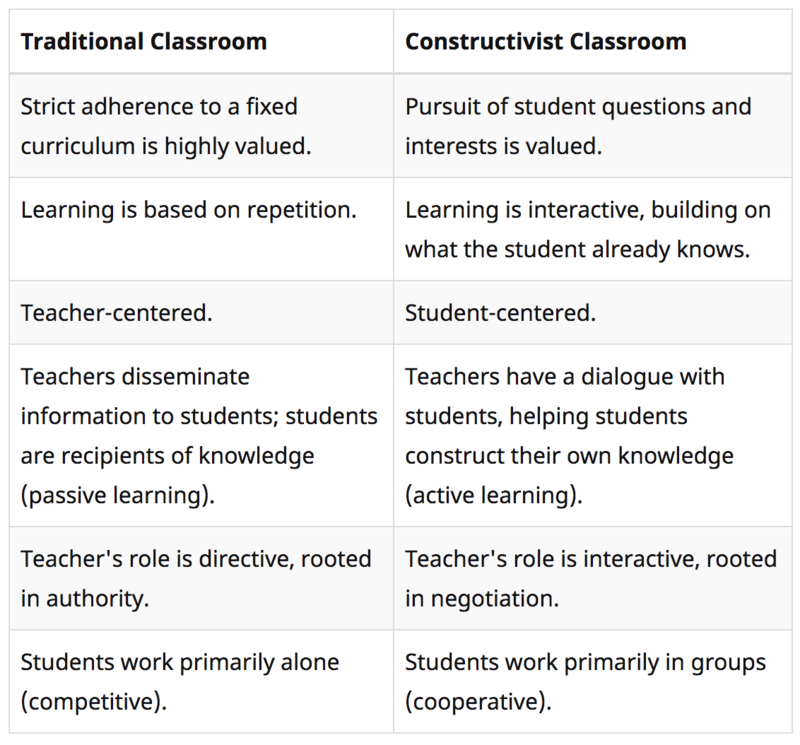Learning, Knowledge and Human Development MOOC’s Updates
Constructivism: A Deep Dive
Constructivism is defined as the approach to learning that the learner constructs their own knowledge and that their reality is affected by the experiences of the learner. Meaning that learning is an active process and not a passive process. Learners are engaged by practicals and experiments to understand concepts rather than just to process the information passively. It is insightful because most traditional schools do not use this approach to learning. They do not focus on the learning process as an activity but rather a necessity of information piled up. The table can show the differences between a constructivist classroom vs a traditional classroom. (https://www.simplypsychology.org/constructivism.html)
Piaget and Vygotsky's constructivists theories are opposing each other but both follow rigid stages of learning. These can sometimes not be the case. Knowledge is actively constructed by learners according to their experiences and surroundings. This means that it is relative to the stage of their experience or cognitive development. (https://www.simplypsychology.org/constructivism.html)
By referencing Piaget’s theory of cognitive development we can see that the two schemas i.e. assimilation and accommodation play a big role in children’s cognitive development. Assimilating your new experiences to the old ones and when the environment changes to accommodate new knowledge. Piaget also believed that to achieve intelligence we need to go through all the stages: Sensori-motor stage, pre-operational stage, concrete operational stage and formal operational stage. (http://www.healthofchildren.com/C/Cognitive-Development.html)
Recent developments on neurosiciences and learning
These days we have a better understanding of the science behind learning. The potential or capacity of a human being is remarkable because they have a learning mindset or a growth mindset others have fixed mindset meaning you got what you got and you believe you cannot change. We can now see through neuroscience that the brain is elastic and can change.
The strengths are that we can have tangible evidence of the brain changing through brain scans. All the stages can be documented and replicated. We can see how the neural pathways are strengthened or created. At first it is weak but over time the pathway is strengthened. The weaknesses are the costs incurred as well as test subject
https://www.youtube.com/watch?v=_nWMP68DqHE
https://www.youtube.com/watch?v=BEMTmumw8Rk
Some insights from constructivists and their approach to "natural learning"
Cognitive development is seen as the thought processes such as thinking, problem-solving, remembering, decision making etc. By referencing Piaget’s theory of cognitive development we can see that the two schemas i.e. assimilation and accommodation play a big role in children’s cognitive development. Assimilating your new experiences to the old ones and when the environment changes to accommodate new knowledge. Piaget also believed that to achieve intelligence we need to go through all the stages: Sensori-motor stage, pre-operational stage, concrete operational stage and formal operational stage. A practical example of children who have not gone through all the stages is Amala and Kamala found in the jungle who missed out on learning in a normal setting and had a tough time developing certain skills like language, walking, associations, decision-making etc. They rather had a more animalistic approach due to the fact that they grew up in the jungle.
On the other hand, Vygotsky's Theory opposed Piaget’s saying directly that learning is a natural aspect and independent, curated by their surroundings and social interactions. Vygotsky’s theory is somewhat seen in the practical example of Kanzi the Bonobo raised by Duane Rumbaugh and Sue Savage-Rumbaugh. They learned to use symbols to communicate with humans and mastered quite a bit of English vocabulary. However, there isn’t much evidence to support that all bonobos or chimpanzees and the rest of the ape family possess the same mastery skills. Since his species does not have much to show for in the wild we can conclude that Kanzi lacks a fundamental function that humans possess in language development. Kanzi can only use what he has been given to communicate and has never tried to describe his mental state.
The natural aspect is therefore apparent. Children learn languages in stages. Up until age 5 it is natural for them to pick up words and associate them with their surroundings, combine words, make phrases and understand the dynamics of language. After the age of 5 it becomes less natural and more difficult for them to make these associations. This does not mean that it is an identical situation for all children. The process of learning, cognitive development and language is different and we should not compare it. Rather focus on their personal development and make sure they reach certain stages.
References:
https://www.youtube.com/watch?v=8I2hrSRbmHE
https://www.youtube.com/watch?v=IhcgYgx7aAA
https://newlearningonline.com/new-learning/chapter-6/supporting-material/kanzi-learns-language
http://www.healthofchildren.com/L/Language-Development.html
http://www.healthofchildren.com/C/Cognitive-Development.html
https://newlearningonline.com/new-learning/chapter-6/supporting-material/the-wolf-children-of-godamuri
https://www.youtube.com/watch?v=_nWMP68DqHE
https://www.youtube.com/watch?v=BEMTmumw8Rk
https://www.simplypsychology.org/constructivism.html
http://www.healthofchildren.com/C/Cognitive-Development.html


